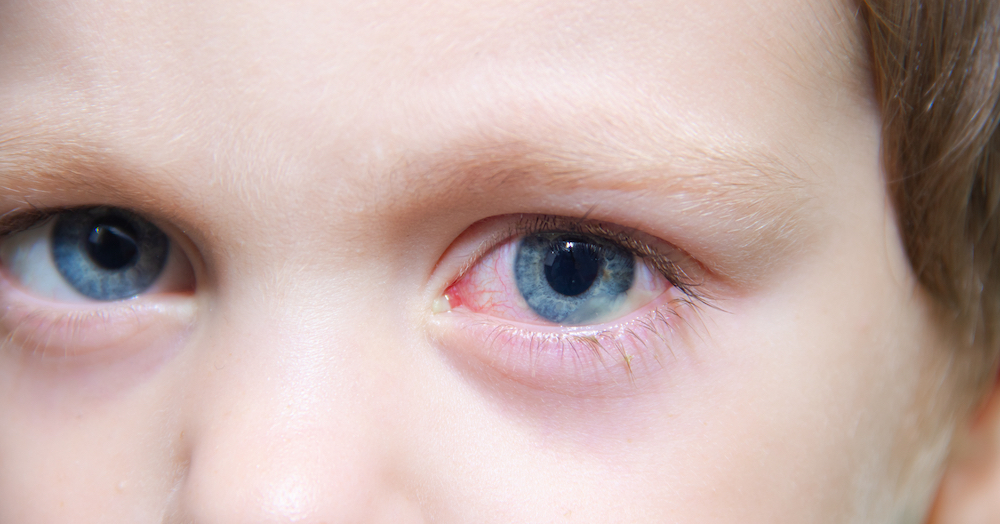Red, watery, and itchy eyes? Lots of goop and eyelids stuck together when you wake up? Yep, sounds like a good ol’ fashioned case of conjunctivitis (pink eye).
This is one of the most common, highly contagious infections out there – and it’s a rare kiddo (and family) that doesn’t get pink eye at least once during the growing-up years.
Think It’s Pink Eye?
Conjunctivitis means “inflammation of the conjunctiva,” the thin, transparent membrane lining the eyelids and eyeballs. However, there are different versions of pink eye. This is why you never want to assume it’s bacterial and use an old bottle of antibiotic eye drops on a current case of pink eye. You might be using the wrong treatment for the infection, making things worse before they get better.
● Bacterial pink eye: Conjunctivitis caused by bacteria is the most likely to produce the green or yellowish mucous that seals eyelashes together and eyes shut. Usually, it requires prescription antibiotic drops if it doesn’t resolve on its own and to prevent its spread to others in the household.
● Viral pink eye: This is a common, secondary result of other viral infections – like colds or cases of flu. In most instances, viral infections resolve on their own. Viral conjunctivitis may be as physically irritating as bacterial versions, and the eyes water quite a bit, but usually, it doesn’t yield as much of the goopy discharge.
● Fungal pink eye: Fungal infections of the eye are rare and typically the result of high candida (yeast) levels. This is probably not your source.
● Allergy-related pink eye: These infections go along with the other symptoms of allergies, like itchy nose and throat, sneezing, congestion, runny noses, etc. Limiting exposure to allergens, replacing HVAC filters, using air purification systems, and over-the-counter allergy medicine (including eye lubricant for allergies) is enough to relieve and minimize inflammation.
It’s always best to contact your pediatrician, perhaps scheduling a video consult, before proceeding.
Symptoms of Pink Eye
Symptoms of pink eye are unmistakable. They start small and rapidly develop into apparent symptoms. It usually starts in a single eye but is so highly infectious that it quickly spreads to the other.
Symptoms of pink eye include:
● A scratchy feeling (like something is in the eye
● Red, irritated-looking eye(s)
● Persistent watering and tearing
● Eye goop that is thicker than usual (and may appear white, yellow, or greenish)
● Eyelashes and lids sticking together (particularly after nap/sleep times)
● Light sensitivity
If one of your family members looks like they have pink eye, contact their physician. Also, if the patient wears contacts, throw them away and wear glasses until the infection heals. In the meantime, there are things you can do to provide pink eye relief.
Treating conjunctivitis at home
In truth, antibiotics or antivirals aren’t necessary to treat pink eye. Careful treatment at home can resolve pink eye within several days to a week or so. However, it’s so contagious that most people prefer to keep the infections as short as possible.
Plus, due to its contagious nature, individuals with pink eye must stay home from school and work, making quick treatment a priority for families with two working parents. Whether you choose to use DIY pink eye remedies (below) or prescription eye drops from the physician, the following tips can soothe irritated eyes.
1. Moist compresses
Frequent eye baths and moist compresses are among the best ways to gain physical relief while keeping eyes clean and mucous-free. Use a clean, fresh cloth each time to minimize the risk of infection spread.
2. Regular applications of preservative-free eye dropsFlushing bacteria or viruses out of the eyes relieves and helps the immune system fight the infection. If you know allergies cause inflammation, over-the-counter eye drops are a good solution, as they provide itch relief and a soothing bath.
If the infection is bacterial or viral in nature, purchase preservative-free eye drops (such as Systane or Refresh labeled “preservative-free). Use them every hour or so to flush the eyes and provide relief. Ensure you catch the run-off with a clean rag (and throw it into the laundry) and wash your hands.
3. Look for Eyebright-infused drops at a health store
Eyebright has been an herb used to treat eye infections and irritation for thousands of years. Visit a local health food store and ask for eyedrops that include eyebright. In addition to its soothing properties, eyebright-infused drops or eye baths may help clear infections faster. Again, use a clean cloth or disposable tissue to catch the run-off, discard the cloth, and wash your hands.
4. Avoid rubbing your eyes and regularly wash your hands
We’ve already mentioned that eye infections are highly contagious. Frequent handwashing is a must. It’s also smart to regularly wash faucet handles and door knobs to keep them free of infectious bacteria or viruses. We understand this isn’t easy with little ones, but do what you can.
5. Get lots of sleep, eat well, and hydrate
Not surprisingly, the body’s immune system fares best when it’s nourished, rested, and hydrated. Even if the patient with the eye infection feels just fine otherwise, they should live life as if they’re recovering from an illness – eating healthy foods, drinking lots of water, and getting plenty of sleep. Extracurricular activities should be passed on until the eye clears up to minimize the risk of spreading it to others.
Contact PANW If You Suspect Someone Has Pink Eye
Do you suspect you or someone else in the family has pink eye? Contact us here at Pediatric Associates of the Northwest. We’ll ask you a handful of questions and then tell you how to proceed. In most cases, if you have a bacterial infection, we can prescribe antibiotic drops without an in-person visit so you can pick them up ASAP to begin treatment.4.





